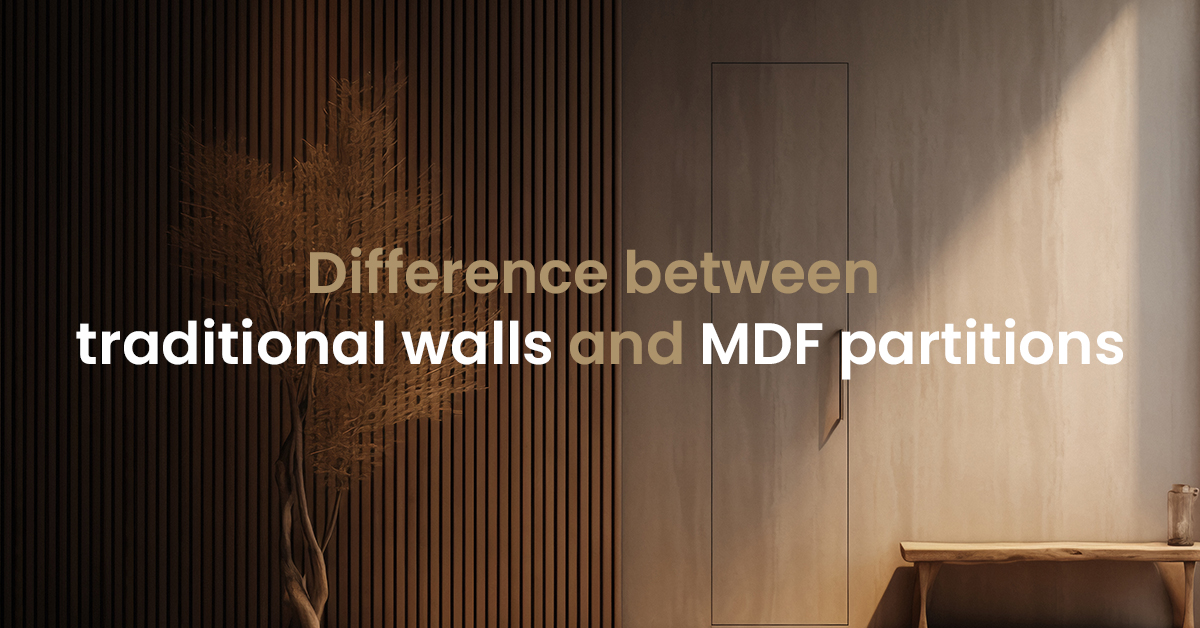Get Support
07496822205
Difference between traditional walls and MDF partitions

In the evolving landscape of interior design and architecture, the choice between traditional walls and MDF (Medium Density Fiberboard) partitions has become a pertinent topic. They can be used interchangeably; the uniqueness follow from their individual strengths and uses which then sets them apart. This blog digs into the differences between traditional walls and MDF partitions, highlighting their characteristics, applications, and suitability for different environments.
Traditional Walls: Timeless and Sturdy
Till centuries traditional walls that mostly have been made of materials like bricks, stones or concrete as basic construction material. They are famous for the high density, durability and soundproofing characteristics—a perfect insulation hi-tech. In contrast to this, these walls are set structures with which a vast amount of labor to construct. They are excellent structural materials for exterior walls and compressive load-bearing systems, where strength is a foremost concern.
Advantages of Traditional Walls:
- Durability and Longevity: The walls of our beloved buildings, however, continue to serve after time with minimal maintenance required.
- Insulation: They show great potential when it comes to insulation requirements for thermal and noise, thus ensuring energy savings and comfort.
- Strength: It is imperative that whatever material is used can carry heavy loads as well, since these walls are a core part of the structure's stability.
Limitations:
- Cost and Time: A number of things make it difficult to build a traditional wall, including access to materials and labor costs.
- Inflexibility: The reparation and adaptation of the already installed walls is impracticable; therefore, the need for innovative solutions to a changing environment is highlighted.
- Weight: Conventional brick, block, and mortar walls with a strong foundation entail a high production expense.
MDF partitions: vital and cutting-edge
Likewise, MDF separators are a more modern and flexible option for separating rooms in a building. Done with the glue made of wood chips, wax, and resin, and the panels being one of their kind, the medium-density fiber is generally known for its smoothness, uniform density, and diversity of properties. The panels are lighter, simpler to install, and more affordable than the walls fixed in the traditional way. The walls are therefore an option for dividers where no structural support is required. For your space, choose MDF from the best MDF manufacturer in Haryana and experience strength and durability.
Advantages of Partitions:
- Versatility: MDF is easy to texture or paint, enabling the creation of an expanded range of textures and designs to suit different styles and tastes.
- Cost-Effectiveness: They come at a much lower cost and are less time-consuming in the installation process, making them excellent choices for projects that can’t afford to be expensive or take longer than expected.
- Flexibility: MDF walls are often removable, relocatable, or simply better changed whenever required, meaning that interior space may be changed with no glitches.
Limitations:
- Durability: Despite the dependable nature of MDF, when compared to the lifespan and endurance of conventional wall materials, it has no match.
- Moisture Sensitivity: MDF can soak up moisture and become out of shape when exposed, which requires lots of effort as well as special treatment to be able to use it in damp places.
- Lower Insulation: Do not forget that the MDF partitions cannot put themselves in place of traditional walls; therefore, the need for the installation of additional insulation materials might arise.
Applications and suitability
The MDF drywall partition and traditional wall competition is an issue when deciding on the project's concrete requirements. The walls of an ordinary house are usually best in areas where the exterior walls can act as a superstructure and where there is a high requirement for insulation and privacy. They are suitable for the application in cases where the structure is intended to stand for a long time without clear deterioration.
While MDF goes great in interiors where flexibility and beauty are important, plywood shows best on exterior scenes where waterproofing and wood tones are needed. They perform well in the office environment, home interiors, and building interiors, where they have to be changed in order to meet the needs and preferences that may change from time to time. MDF is known as one of the most universal materials as it is used for both decoration elements, like cabinetry and furniture, because it can be easily shaped and finished to create a smooth and well-defined surface. Are you trying to find the best MDF manufacturers in India? No need to worry; go to our website and give yourself a relief sign; we have everything you need.
Conclusion
The choice between traditional walls and MDF partitions significantly influences the aesthetic, functionality, and durability of a space. Traditional walls offer unmatched strength and longevity, making them ideal for exterior and load-bearing applications. MDF partitions, with their versatility and cost-effectiveness, provide an excellent solution for interior divisions where flexibility and aesthetic diversity are desired. Understanding the distinct advantages and limitations of each option allows architects, designers, and homeowners to make informed decisions tailored to their specific needs and preferences, creating spaces that are not only functional but also aligned with their vision and style.

 By: Ethan
By: Ethan